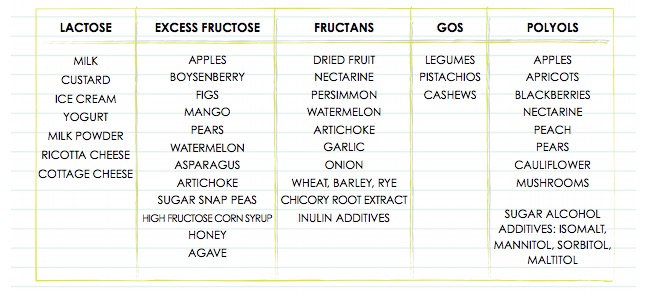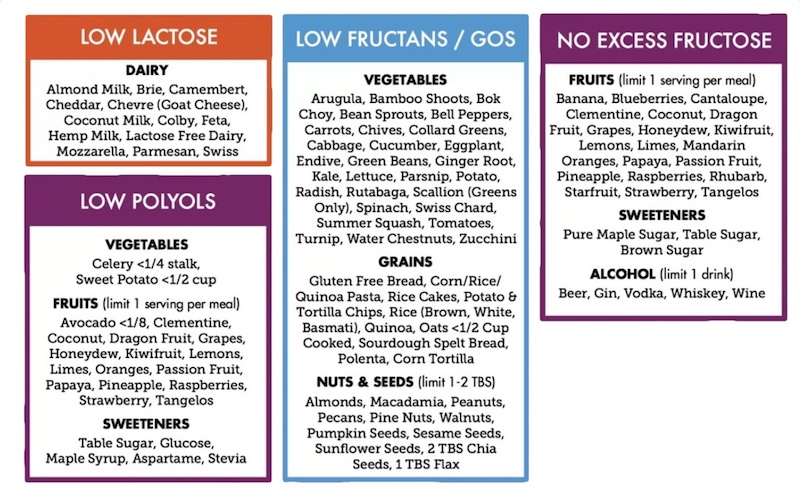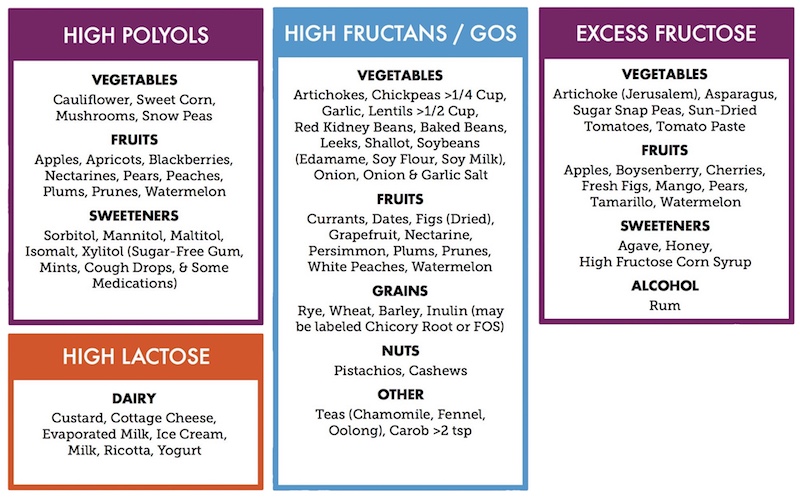Low FODMAP Diet, High FODMAP Foods and IBS
FODMAP looks as though it must be a misspelling, especially since it’s linked to the word diet. In fact, it’s an acronym that describes certain carbohydrates in foods that can cause chronic gastrointestinal symptoms and make you miserable with gas, diarrhea or constipation. Correcting your diet, however, can make a big difference, especially for those who suffer from problems like irritable bowel syndrome (IBS).
What Are FODMAPs?
FODMAP stands for fermentable oligosaccharides, disaccharides, monosaccharides and polyols (you can see why an acronym is used!). Here’s a bit about each term:
Fermentable means a substance that is broken down or fermented by beneficial bacteria found in the large bowel.
Oligosaccharides are molecules made of individual sugars joined together in a chain. (fructans)
Disaccharides are double sugar molecules. (lactose, milk sugar)
Monosaccharides are single sugar molecules. (excess fructose)
And
Polyols are sugar alcohols – not the sort that can cause intoxication.
Saccharide simply means sugar alcohols, like mannitol and sorbitol.

Saccharides and polyols are carbohydrates. When poorly digested, they ferment in the bowel – the lower part of the large intestine. During the fermentation process, these molecules draw in water. Fermentation also produces carbon dioxide, hydrogen and methane gases, which cause the intestine to become distended. As a result, you become bloated, have pain, abdominal distention and diarrhea or constipation. The primary problem with high FODMAP foods is that over time, they can upset the balance of beneficial bacteria in the gut – a condition called gut dysbiosis. It is the fermentation process that causes dysbiosis, as the beneficial bacteria need specific environmental conditions to thrive and multiply.
FODMAPs and Diseases
For those whose symptoms are related to FODMAPs, dietary changes can often bring relief. A low FODMAP diet may be helpful to those who suffer from irritable bowel syndrome, as well as other intestinal conditions like functional gastrointestinal disorder and small intestine bacterial overgrowth. In addition, a low FODMAP diet can also help relieve symptoms of rheumatoid arthritis, fibromyalgia or migraines that seem to be related to certain foods.
FODMAPs and Irritable Bowel Syndrome
IBS affects as many as 20 percent of Americans. It is a chronic condition characterized by altered bowel habits. IBS symptoms may include bloating, diarrhea, constipation and abdominal pain. The gut is chronically inflamed and irritated, and stools may be bloody and/or contain large quantities of mucus. There is considerable research on IBS and FODMAPs. As many as two-thirds of patients with IBS report that certain foods trigger their symptoms. Foods high in FODMAPs are among the causes that contribute to the inflammation in the gut. In one Australian trial that compared patients with IBS to those without IBS, a low FODMAP diet reduced symptoms in the IBS group by 50 percent. Other studies have shown similar or even better results, with up to 75 percent of patients reporting improvements. In most cases, symptoms were reduced or eliminated within one week of starting a low FODMAP diet. In particular, patients reported less bloating, gas and abdominal pain on a low FODMAP diet.
What’s a Low FODMAP Diet?
First, you must understand that a low FODMAP diet is very restrictive. It is not meant to be a permanent eating pattern. Instead, the idea behind a low FODMAP diet is to give your gut a chance to heal. A low FODMAP diet allows the gut to restore the normal balance of beneficial bacteria and heal inflammation in the gut wall. The restrictive diet lasts for about three to eight weeks. Once your body has adjusted and “reset,” you will gradually begin to add individual FODMAPs back into the diet. You do this by adding a single food you have previously avoided, such as cabbage or apples. If you don’t have any symptoms after one week, that food should be safe to eat and you can try another food. If the gastrointestinal or other symptoms return, you must continue to avoid that food.
Low FODMAP Foods

The infographic contains a detailed list of low FODMAP foods, but here are some basics:
Vegetables: broccoli, Brussels sprouts, butternut squash (¼ cup only), carrots, celery, corn (½ cob) cucumbers, kale, green beans, green leaves but not bulbs of leeks and scallions, lettuce, potatoes, pumpkin, summer squash, spinach and tomatoes.
Fruits: bananas, blueberries, grapes, honeydew melon, kiwifruit, lemons, oranges, fresh pineapple, raspberries and strawberries.
Meats: almost all meats, poultry, seafood and shellfish
Grains: most wheat-free and gluten free breads and baked products, buckwheat, rice, oatmeal
Nuts and Seeds: nuts, pumpkin seeds, sesame seeds, sunflower seeds (may need to limit amounts)
Condiments and Beverages: mayonnaise, strawberry jam or jelly, ketchup, mustard, soy sauce, alcohol (limited), coffee, tea, small amounts of low FODMAP fruit juices.
Dairy products: butter, eggs, cheese, almond and other lactose-free milks, whipped cream, lactose-free yogurt.
High FODMAP Foods

The infographic contains a detailed list of high FODMAP foods, but here are some basics:
Vegetables: artichoke, asparagus, dried beans, lima beans, soybeans, cabbage, garlic, leaks, onions, peas.
Fruits: apples, apricots, avocados, blackberries, cherries, figs, grapefruit, peaches, pears, raisins, watermelon.
Meats: chorizo, sausage and processed meats.
Grains: wheat and all wheat products such as bread, baked goods, cookies and pasta; rye, spelt and almond meal.
Nuts and Seeds: cashews and pistachios
Condiments and Beverages: gravy with flour or onion, hummus, honey, mixed berry jam, relish, tahini and prepared foods that contain polyol sweeteners like xylitol; beer, rum, tea with added sweeteners, fruit juices like apple juice or pear nectar.
Dairy products: milk, buttermilk, ricotta cheese, custard, gelato, ice cream.
If you have IBS or similar problems, it is well worth the time to try a FODMAP diet. It may be wise to consult a knowledgeable physician or dietitian first. If you tried the FODMAP diet before, please share your story with others by leaving a comment below.